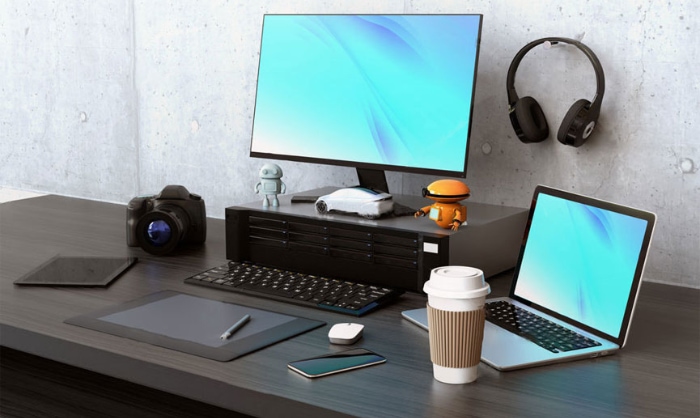Do All Monitors Have Speakers? Breaking Down the Facts

Monitors have journeyed a long way from bulky CRTs to sleek, multifunctional displays. Amidst this evolution, one question frequently pops up: Do all monitors come equipped with speakers?
This isn’t just about ticking off a feature on a spec sheet; it’s about how integral audio is to our interactive experiences, whether for gaming, professional tasks, or casual web browsing. As we dive into this exploration, we’ll unravel the mysteries behind monitor design choices, particularly the inclusion or absence of built-in speakers.
So, let’s turn up the volume on this topic and discover what lies behind the screens in front of us.
The Presence of Speakers in Monitors
When exploring the world of monitors, one feature that varies significantly across different models is the inclusion of built-in speakers. This aspect of monitor design often reflects the intended use and target audience of the device.
Trends in Monitor Design
Monitors have evolved to cater to diverse needs, from gaming to professional graphics work. Built-in speakers are more common in models designed for general use or multimedia consumption.
These monitors offer a convenient, all-in-one audiovisual experience for users who prefer a minimalist setup or lack the space for external speakers. On the other hand, high-end monitors, especially those tailored for professional or gaming use, may omit built-in speakers to focus on superior display qualities, like color accuracy and refresh rate.
Reasons Behind the Variance
The decision to include speakers in a monitor hinges on several factors. Cost is a significant consideration; adding speakers can increase the overall price of the monitor.
Space and design constraints also play a role. Slimmer, more streamlined monitors might sacrifice speakers to maintain their sleek profile.
Moreover, manufacturers recognize that users who prioritize high-quality audio often opt for dedicated sound systems, making built-in speakers less critical for some segments of the market.
The User’s Perspective
From the user’s perspective, the presence or absence of built-in speakers can influence the buying decision. Users seeking a simple, plug-and-play solution for casual use might gravitate towards monitors with integrated speakers.
In contrast, audiophiles and professional users might prefer monitors without speakers, as they likely already own advanced audio setups that provide a superior sound experience.
Quality and Purpose of Built-in Speakers
The quality and intended purpose of built-in speakers in monitors vary greatly, reflecting the diversity in user needs and monitor designs. Understanding these aspects helps in making informed choices based on individual audio preferences and usage scenarios.
Evaluating Speaker Quality
The quality of built-in speakers in monitors is often a balancing act between cost, space, and performance. Generally, these speakers are functional for basic audio needs but don’t match the depth and clarity offered by dedicated sound systems.
They are typically fine for system sounds, video calls, and casual media consumption. However, for activities requiring high-fidelity sound, like professional audio editing or immersive gaming, built-in speakers usually fall short.
Purpose and Practicality
Built-in speakers serve a practical purpose. They offer a convenient, space-saving solution for users with limited desk space or those who prefer a less cluttered setup.
These speakers are also beneficial in environments like offices or classrooms, where external speakers may not be feasible due to space or budget constraints. In such settings, having a monitor with integrated speakers simplifies the setup and provides adequate sound for presentations, video conferencing, and basic multimedia tasks.
Customizing Audio Experience
While built-in speakers provide a baseline audio experience, users often have the option to connect external speakers or headphones for enhanced sound quality. This flexibility allows for a customized audio setup, catering to the diverse preferences of users.
Whether it’s for enjoying music, editing videos, or gaming, external audio solutions can significantly elevate the overall experience beyond what built-in speakers typically offer.
Identifying Monitors with Built-in Speakers
Choosing the right monitor often involves understanding its audio capabilities, particularly whether it includes built-in speakers. Identifying monitors with this feature can be straightforward, provided you know what to look for in product specifications and physical design.
Reading Product Specifications
The most reliable way to determine if a monitor has built-in speakers is to check its product specifications. These details are usually found on the manufacturer’s website, in product brochures, or on the packaging.
Look for terms like “integrated speakers,” “built-in speakers,” or specific details about speaker wattage and sound quality. Some specifications may also indicate the number of speakers, offering insights into the stereo capabilities of the monitor.
Visual and Physical Clues
In addition to reading specifications, certain physical attributes can hint at the presence of built-in speakers. Visible speaker grills, small openings or perforations along the monitor’s edges or back panel, are tell-tale signs.
Additionally, some monitors might have volume control buttons or audio interfaces (like headphone jacks) visibly integrated into their design, suggesting the presence of internal speakers.
Checking Connectivity Options
Monitors with built-in speakers often have additional audio connectivity options. These may include HDMI or DisplayPort inputs, which carry both video and audio signals, or a dedicated audio input jack.
While these ports don’t confirm the presence of speakers outright, they are a common feature in monitors that support integrated audio solutions.
User Manuals and Online Resources
If the physical examination and product listing don’t provide clear answers, referring to the user manual can help. Manuals often detail all the features of the monitor, including audio capabilities.
Additionally, online forums, customer reviews, and Q&A sections on retail websites can be valuable resources for confirming the presence of built-in speakers in specific monitor models.
Pros and Cons of Built-in Speakers

Built-in speakers in monitors are a feature that brings both advantages and disadvantages, depending on the user’s needs and expectations. By weighing these pros and cons, you can make a more informed decision about what type of monitor best suits your lifestyle and work habits.
Advantages of Built-in Speakers
Convenience and Space Saving
Monitors with built-in speakers offer a neat, all-in-one solution, eliminating the need for separate audio hardware. This is particularly beneficial for users with limited desk space or those who prefer a minimalist setup.
The integrated design also means fewer cables, contributing to a cleaner, more organized workspace.
Cost-Effectiveness
For users on a budget, monitors with integrated speakers can be cost-effective. They eliminate the need to purchase external speakers, providing a decent audio solution without the additional expense.
This is especially appealing for casual users, students, or those setting up a home office who need a functional audio-visual setup without breaking the bank.
Adequate for Basic Needs
For everyday tasks like video conferencing, watching online tutorials, or casual media consumption, the quality of built-in speakers is generally adequate. They provide a convenient audio source that is perfectly fine for non-critical listening.
Disadvantages of Built-in Speakers
Limited Audio Quality
While convenient, the audio quality of built-in speakers often doesn’t match that of dedicated external speakers or headphones. The sound might lack depth, clarity, and bass, making it less suitable for high-fidelity audio tasks like music production, professional video editing, or immersive gaming experiences.
Design Compromises
Incorporating speakers into a monitor can lead to design compromises. To accommodate speakers, monitors might be larger or thicker, which can detract from the sleek, slim profiles that many users prefer.
Additionally, the focus on integrating speakers might mean trade-offs in other areas, such as display quality or additional features.
Lack of Customization
With built-in speakers, users have limited control over their audio experience. Unlike external audio solutions where you can choose speakers based on specific needs or preferences, built-in speakers offer no such customization.
You’re essentially stuck with the audio quality that comes with the monitor.
Alternatives to Built-in Speakers
For those whose monitors lack built-in speakers or who desire an upgrade in audio quality, there are several alternative options available. Each alternative offers its own set of benefits, tailored to different preferences and usage scenarios.
External Speakers
Wide Range of Choices
The market offers a vast array of external speakers, ranging from budget-friendly models to high-end audio systems. This variety allows users to select speakers based on their specific needs, whether it’s for enhancing music quality, providing clear dialogue in movies, or delivering immersive sound in gaming.
Enhanced Audio Quality
Generally, external speakers provide superior sound quality compared to built-in monitor speakers. They offer better bass, clearer highs, and more detailed sound, significantly improving the overall audio experience for any activity.
Customizable Audio Setups
With external speakers, users have the flexibility to customize their audio setup. This includes the ability to adjust speaker placement for optimal sound, choose between wired or wireless options, and even integrate a subwoofer for additional bass.
Headphones and Headsets
Immersive and Personal Audio
For those who prefer a more personal audio experience or need to keep the noise down, headphones and headsets are ideal. They provide immersive sound directly to the ears, which is great for gaming, private listening, or in environments where noise should be minimized.
Versatility and Convenience
Headphones and headsets come in various styles and with different features, such as noise-cancellation, wireless connectivity, and built-in microphones. This makes them versatile for multiple uses, from casual listening to professional audio work.
Soundbars
Space-Efficient Design
Soundbars offer a compact, space-efficient solution for improving audio. Designed to sit neatly under the monitor, they are ideal for those who want better sound without the clutter of traditional speakers.
Balanced Sound Experience
Soundbars typically provide a more balanced audio experience than built-in speakers. They are engineered to deliver clearer vocals, more detailed sound, and often come with built-in subwoofers for enhanced bass, making them suitable for movies, music, and gaming.
Portable Bluetooth Speakers
Flexibility and Portability
For users who value flexibility, portable Bluetooth speakers are an excellent choice. They can be used with the monitor for improved audio and taken on the go for music or audio anywhere.
Ease of Use
Bluetooth speakers are easy to set up and use, often just requiring a simple pairing with a device. This makes them user-friendly and convenient for those not wanting to deal with cables or complex setups.
Conclusion
Monitors with built-in speakers offer a blend of convenience and functionality, fitting well into various setups, from minimalistic workstations to compact living spaces. However, as we’ve seen, they often come with limitations in sound quality, leading many users to explore alternative audio solutions.
The choice between a monitor with built-in speakers and one without largely depends on individual needs, preferences, and the specific audio quality required for different activities.
External speakers, headphones, soundbars, and portable Bluetooth speakers each present their unique advantages, catering to a wide range of audio needs and environments. Whether it’s the immersive experience offered by high-quality external speakers, the personal touch of headphones, the sleek design of soundbars, or the versatility of portable Bluetooth options, the alternatives to built-in speakers are plentiful and diverse.
Understanding the role and capabilities of built-in speakers, as well as the various alternatives available, empowers users to make choices that best suit their audio needs and enhance their overall experience with their devices. With this knowledge, you can select a monitor and audio setup that aligns perfectly with your lifestyle, work requirements, and entertainment preferences, ensuring a satisfying and well-rounded audio-visual experience.



